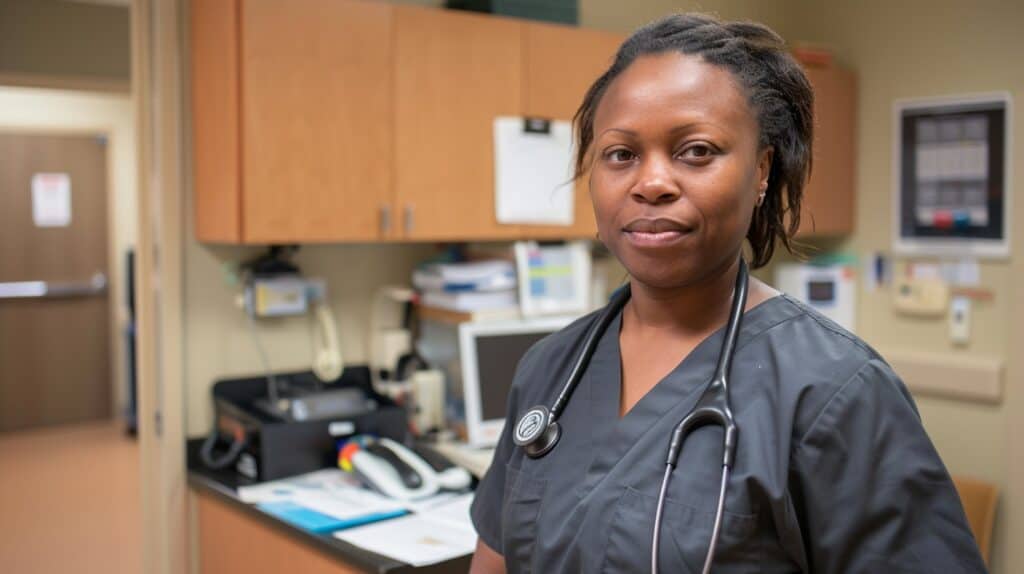Becoming a medical assistant is a smart career move. The field is growing fast, with 16% job growth expected by 2031. 3 This means more job opportunities and job security for those who enter the field.
Medical assistants play a key role in healthcare, working with doctors and nurses to provide patient care. This guide will walk you through the 7 steps to become a medical assistant.
It covers everything from getting your high school diploma to finding your first job. 2
Key Takeaways
Medical assistant jobs are growing fast, with 16% growth expected by 2031 and 114,600 annual job openings projected through 2032.
To become a medical assistant, you need a high school diploma or GED, then enroll in an accredited program to earn a certificate or associate degree.
Getting certified as a CCMA, CMA, or RMA can boost job prospects and pay, with median salaries reaching $37,190 in 2021.
Key skills for medical assistants include clinical procedures, administrative tasks, and strong communication abilities.
Externships provide hands-on experience, while entry-level jobs offer opportunities to build skills in various healthcare settings.
Table of Contents
Educational Pathways to Become a Medical Assistant

Becoming a medical assistant starts with education. You can choose between certificate programs or associate degrees in medical assisting.
High School Diploma or GED Requirement
A high school diploma or GED is the minimum requirement for aspiring medical assistants. This foundational education provides essential skills in math and science, crucial for success in the field.
Accredited medical assistant programs mandate this baseline qualification, ensuring students are prepared for the rigorous training ahead. 1
Education is the passport to the future, for tomorrow belongs to those who prepare for it today. – Malcolm X
Math and science classes in high school lay the groundwork for future medical assistants. These courses develop critical thinking and analytical skills necessary for handling patient data, understanding medical terminology, and performing clinical tasks.
The GED test offers an alternative path for those without a traditional diploma, covering key subjects like math, science, and language arts. 2
Enrolling in an Accredited Medical Assistant Program
After securing your high school diploma or GED, the next crucial step is enrolling in an accredited medical assistant program. Accreditation by the Commission on Accreditation of Allied Health Education Programs (CAAHEP) or Accrediting Bureau of Health Education Schools (ABHES) ensures quality education. 3 These programs offer certificates, diplomas, or associate degrees, providing comprehensive training in clinical procedures, administrative tasks, and patient care. SJVC stands out with small class sizes and hands-on opportunities, preparing students for real-world scenarios.
Virtual medical assistant training modules may supplement traditional coursework, offering flexibility and modern skill development.
Programs typically cover anatomy, physiology, medical billing, and electronic health records management. Students learn to perform vital sign measurements, administer medications, and assist with minor surgical procedures.
Administrative training includes scheduling appointments, managing patient records, and insurance processing. Hands-on experience through externships in hospitals or clinics solidifies classroom knowledge, readying graduates for certification exams and entry-level positions in various healthcare settings. 2
Options for Medical Assistant Certification

Certification options for medical assistants open doors to better jobs and higher pay. You can choose from becoming a Certified Clinical Medical Assistant, a Certified Medical Assistant, or a Registered Medical Assistant.
Becoming a Certified Clinical Medical Assistant (CCMA)
The National Healthcareer Association offers the Certified Clinical Medical Assistant (CCMA) certification. This credential proves mastery of top industry standards. 4 Men can prepare through a 4-month online program, covering essential medical assistant skills.
The CCMA exam tests knowledge in a 3-hour session, evaluating clinical and administrative abilities. Passing earns official recognition as a qualified medical assistant, opening doors to healthcare careers.
CCMAs perform vital roles in medical offices and clinics. They take patient histories, assist with exams, and handle lab work like blood draws. On the admin side, CCMAs schedule appointments, manage records, and process insurance claims.
The certification shows employers you have the skills to excel in both clinical and office tasks. It’s a respected credential that can boost job prospects and earning potential for guys entering the medical field. 5
Achieving Certified Medical Assistant (CMA) Status
Transitioning from CCMA, aspiring medical assistants can pursue Certified Medical Assistant (CMA) status. This prestigious certification, offered by the American Association of Medical Assistants (AAMA), requires completion of an accredited medical assisting program and passing a rigorous exam.
CMAs demonstrate expertise in clinical procedures, administrative tasks, and medical ethics. The certification costs between $2,000 and $60,000, depending on the program chosen. 2 CMAs enjoy enhanced job prospects, with a projected 23% growth in opportunities over the next decade. 2 Their median salary reached $37,190 in 2021, reflecting the value placed on this certification by healthcare employers.
Obtaining Registration as a Medical Assistant (RMA)
Registration as a Medical Assistant (RMA) offers a path to professional recognition. Candidates must complete an accredited medical assisting program or gain equivalent work experience. 7 The RMA exam, priced at $120, tests knowledge in anatomy, physiology, and medical terminology. 6 Clinical skills assessment forms a crucial part of the certification process.
RMA certification demonstrates competence and commitment to excellence in medical assisting.
Different states have varying credential requirements for medical assistants. 6 Aspiring RMAs should check their local regulations. The next step involves mastering key skills for medical assistants.
Key Skills for a Medical Assistant

Medical assistants need a mix of clinical and office skills. They must be quick learners, detail-oriented, and good at talking with patients and doctors.
Mastering Clinical Procedures
Mastering clinical procedures demands precision and practice. Medical assistants must excel in various technical skills, from taking vital signs to administering injections. Proficiency comes through hands-on experience and repetition.
Accuracy is paramount – assistants should practice under supervision until they achieve consistent results. 8 This commitment to excellence ensures patient safety and builds trust with healthcare teams.
Staying current with evidence-based guidelines is crucial in this rapidly evolving field. Medical assistants need to continuously update their knowledge and skills. 9 They should familiarize themselves with new medical devices and technologies.
Regular training sessions and workshops help maintain proficiency in core procedures like phlebotomy, EKG administration, and wound care. Attention to detail and adherence to protocols are non-negotiable aspects of clinical mastery.
Handling Administrative Responsibilities
Medical assistants juggle crucial administrative tasks daily. They manage patient schedules, update medical records, and handle billing processes. Proficiency in medical coding and insurance claim procedures is essential.
Computer skills are vital – electronic health records (EHR) systems are now standard in most healthcare facilities. 10
Effective administrative skills are the backbone of any successful medical practice.
Medical assistants often serve as the first point of contact for patients. They answer phones, greet visitors, and coordinate communication between patients and healthcare providers.
Maintaining patient confidentiality is paramount. Mastery of these administrative duties ensures smooth clinic operations and enhances patient care. 11
Enhancing Communication Abilities
Handling administrative tasks smoothly transitions into enhancing communication abilities – a cornerstone of medical assisting. Clear, empathetic communication fosters trust and improves patient care.
Medical assistants must master both verbal and non-verbal cues to effectively interact with patients, doctors, and colleagues. 12
Developing strong listening skills is crucial. Pay attention to patients’ concerns, ask clarifying questions, and show understanding through body language. Practice explaining medical procedures in simple terms, avoiding jargon.
Cultivate a calm, reassuring demeanor to put anxious patients at ease. Learn to adapt communication styles for diverse patient populations, including elderly, pediatric, or non-native English speakers.
Hone your ability to convey complex information clearly and concisely, ensuring patients fully comprehend their care instructions. 11
Building Experience as a Medical Assistant

Hands-on practice is key. Externships and entry-level jobs give you real-world skills… Want to know more about becoming a medical assistant?
Participating in Externships and Practicums
Externships and practicums are crucial for aspiring medical assistants. These hands-on experiences offer real-world exposure in clinical settings. Students shadow seasoned professionals, performing tasks like drawing blood and taking vital signs.
This practical training occurs in diverse environments – from bustling hospitals to small family practices. 13
Externships bridge the gap between classroom learning and real-world medical assisting.
Practical experience is invaluable for future medical assistants. It builds confidence, hones skills, and provides networking opportunities. Many students find job offers through their externship connections.
The American Association of Medical Assistants recommends 160 hours of supervised clinical practice for optimal preparation. 14
Securing Entry-Level Medical Assistant Positions
Transitioning from externships, job seekers can leverage their practical experience to secure entry-level medical assistant positions. Career services departments offer valuable assistance in this process. 15 Research potential employers thoroughly – focus on medical clinics, outpatient centers, and primary care facilities in your desired area. Entry-level roles provide opportunities to build skills and gain real-world experience. 2 Many healthcare professionals start their careers in these positions, honing clinical procedures and administrative responsibilities. Tailor your resume to highlight relevant coursework, certifications, and hands-on training.
Emphasize your knowledge of electronic health records, medical law, and patient advocacy to stand out to potential employers.
Career Advancement in Medical Assisting

Medical assistants can climb the career ladder through specialization and extra certifications. Want to know more?
Exploring Specializations in Medical Assisting
Medical assisting offers diverse career paths. Specialists focus on clinical, administrative, pediatric, ophthalmic, or geriatric areas. Each specialization requires unique skills and knowledge.
Clinical specialists handle lab work and patient care. Administrative experts manage front desk operations and electronic health records. Pediatric assistants work with children in various healthcare settings.
Ophthalmic specialists aid eye doctors, while geriatric experts support elderly patients. Job availability varies by specialization. Research each option thoroughly. 16 Talk to professionals in the field.
Consider your strengths and career goals. Choose a path that aligns with your interests and local job market demands. Proper disposal of medical waste is crucial in all specializations. 17
Pursuing Further Certifications
Medical assistants boost their careers through advanced certifications. Specialty areas like geriatrics, ophthalmology, and podiatry offer unique opportunities. Certified Clinical Medical Assistants (CCMAs) can pursue Registered Medical Assistant (RMA) status for broader recognition.
These credentials open doors to higher pay and leadership roles in healthcare settings.
Continuing education keeps medical assistants sharp and competitive. Online learning platforms provide flexible options to gain new skills. Certifications in electronic health records (EHRs) or medical coding enhance job prospects.
Stepful’s 4-month program preps candidates for CCMA certification, a valuable credential in the field. 2
Employment Prospects and Advantages of Being a Medical in Assistant

Medical assistants enjoy strong job prospects, with steady growth expected in the field. This career offers stability, flexible hours, and chances to work in various healthcare settings.
Want to learn more about becoming a medical assistant? Keep reading!
Projected Employment Growth for Medical Assistants
Medical assistant jobs are booming. Career prospects look bright for those entering this field.
| Employment Growth Projections | Details |
|---|---|
| Growth Rate (2022-2032) | 14% |
| Annual Job Openings | 114,600 |
| Median Annual Salary (2023) | $42,000 |
| Previous Growth Rate (2021-2031) | 16% |
These numbers show strong demand for medical assistants. 19 Job security in this field remains high. 20 Healthcare facilities need more support staff. Aging populations drive this growth. Technology advances create new roles. Specializations offer paths for career advancement. Flexibility in work settings adds appeal. Entry-level positions often lead to promotions. Continuous learning opens doors to higher pay. The field rewards those who stay current with medical trends.
Benefits of Job Stability and Flexibility
Job stability and flexibility go hand-in-hand for medical assistants. This career offers steady employment with a projected 16% growth from 2021 to 2031. 21 Men can enjoy diverse work settings – from hospitals to private practices.
Medical assistants earn competitive wages, with those in Connecticut averaging $41,010 annually in 2021. The field allows for quick entry, often within two years, and provides opportunities to specialize in areas like OB-GYN or podiatric surgery.
Flexible schedules accommodate personal commitments, making it an attractive option for career changers or those seeking work-life balance. 22
People Also Ask
What education do I need to become a medical assistant?
You need an associate degree in medical assisting. Study anatomy, physiology, and medical law. Some get bachelor’s degrees for more options.
Are there certifications for medical assistants?
Yes. Certified Medical Assistants (CMA) is a common one. It shows you know your stuff. Employers like it.
Can I start as something else in healthcare?
Sure. Many start as nurse’s aides or CNAs. It’s good experience. You learn about patient care.
What skills do medical assistants need?
They take medical histories, help with exams, and give meds. IV infusion skills are useful. Know about prescriptions too.
Where do medical assistants work?
They work in many places. Doctors’ offices, outpatient care, and nursing homes need them. Some work with chiropractors or in pharmacies.
How’s the job outlook for medical assistants?
It’s growing fast. The healthcare industry needs more MAs. You can advance to roles like pharmacy tech or even nursing with more school.
References
^ https://nursejournal.org/careers/medical-assistant/how-to-become/
^ https://www.stepful.com/post/how-to-become-a-medical-assistant
^ https://www.tealhq.com/how-to-become/medical-assistant
^ https://www.stepful.com/post/certified-clinical-medical-assistant
^ https://www.nhanow.com/certification/nha-certifications/certified-clinical-medical-assistant-(ccma)
^ https://research.com/careers/how-to-become-a-certified-medical-assistant
^ https://medassisting.org/how-to-become-a-registered-medical-assistant/
^ https://rosseducation.edu/blog/a-guide-to-mastering-clinical-procedures-as-a-medical-assistant/
^ https://careertraining.wnc.edu/training-programs/certified_clinical_medical_assistant/
^ https://campus.edu/blog/medical-assisting/medical-assistant-skills (2023-02-22)
^ https://www.allalliedhealthschools.com/blog/medical-assistant-skills/
^ https://nwsc.edu/top-7-skills-every-medical-assistant-needs-to-succeed/ (2023-10-27)
^ https://prospectcollege.edu/blog/how-to-become-a-medical-assistant-the-steps-you-cant-ignore/
^ https://www.aiam.edu/medical-assisting/how-to-become-a-medical-assistant/ (2022-11-23)
^ https://prismcareerinstitute.edu/blog/best-ways-to-build-experience-as-an-entry-level-medical-assistant/
^ https://www.hmi.edu/exploring-specializations-in-medical-assisting-which-path-is-right-for-you/ (2024-07-15)
^ https://www.accreditedschoolsonline.org/healthcare/medical-assistant/advanced-career-guide/
^ https://nwsc.edu/become-successful-medical-assistant-7-tips/
^ https://www.bls.gov/ooh/healthcare/medical-assistants.htm
^ https://prismcareerinstitute.edu/blog/the-outlook-for-medical-assistant-jobs/ (2022-10-21)
^ https://www.goodwin.edu/enews/benefits-of-being-a-medical-assistant/ (2023-03-24)
^ https://www.99mgmt.com/blog/10-benefits-of-work-in-the-medical-assistant-field




